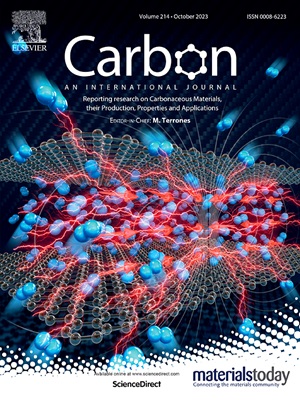气相沉积法中添加Fe和Al促进超高密度碳纳米管森林的生长
IF 10.5
2区 材料科学
Q1 CHEMISTRY, PHYSICAL
引用次数: 0
摘要
碳纳米管(CNT)森林的密度随着长度的增加而明显下降,这主要是由于生长过程中催化活性的减弱。在这里,我们报告了一种结合铁和铝添加剂的气相合成策略,该策略产生的碳纳米管森林密度大大高于传统方法生产的碳纳米管森林。值得注意的是,高度为1.3毫米的碳纳米管森林实现了149毫克/立方厘米的质量密度,这是报道的高度超过1毫米的森林的最高密度。这种改善是由于Fe和Al的协同作用延长了催化剂颗粒的寿命,有效地抑制了生长过程中的密度衰减。此外,我们研究了这些超高密度碳纳米管森林的电阻率,以阐明其宏观导电特性。这种方法克服了密度衰减的固有限制,并为将碳纳米管森林集成到先进的器件技术中开辟了新的机会。本文章由计算机程序翻译,如有差异,请以英文原文为准。
Enhanced growth of ultra-high density carbon nanotube forests via Fe and Al vapor addition in a CVD process
Carbon nanotube (CNT) forests suffer from a pronounced density decline as their length increases, primarily due to diminishing catalytic activity during growth. Here, we report a vapor-phase synthesis strategy incorporating Fe and Al additives that yields CNT forests with substantially higher densities than those produced by conventional methods. Notably, a CNT forest with a height of 1.3 mm achieved a mass density of 149 mg/cm3, the highest reported for forests exceeding 1 mm in height. This improvement is attributed to the prolonged lifetime of catalyst particles afforded by the synergistic effects of Fe and Al, which effectively suppress density decay during growth. Moreover, we investigated the electrical resistivity of these ultra-high-density CNT forests to elucidate their macroscopic conduction properties. This approach overcomes the intrinsic limitations of density decay and opens new opportunities for integrating CNT forests into advanced device technologies.
求助全文
通过发布文献求助,成功后即可免费获取论文全文。
去求助
来源期刊

Carbon
工程技术-材料科学:综合
CiteScore
20.80
自引率
7.30%
发文量
0
审稿时长
23 days
期刊介绍:
The journal Carbon is an international multidisciplinary forum for communicating scientific advances in the field of carbon materials. It reports new findings related to the formation, structure, properties, behaviors, and technological applications of carbons. Carbons are a broad class of ordered or disordered solid phases composed primarily of elemental carbon, including but not limited to carbon black, carbon fibers and filaments, carbon nanotubes, diamond and diamond-like carbon, fullerenes, glassy carbon, graphite, graphene, graphene-oxide, porous carbons, pyrolytic carbon, and other sp2 and non-sp2 hybridized carbon systems. Carbon is the companion title to the open access journal Carbon Trends. Relevant application areas for carbon materials include biology and medicine, catalysis, electronic, optoelectronic, spintronic, high-frequency, and photonic devices, energy storage and conversion systems, environmental applications and water treatment, smart materials and systems, and structural and thermal applications.
 求助内容:
求助内容: 应助结果提醒方式:
应助结果提醒方式:


